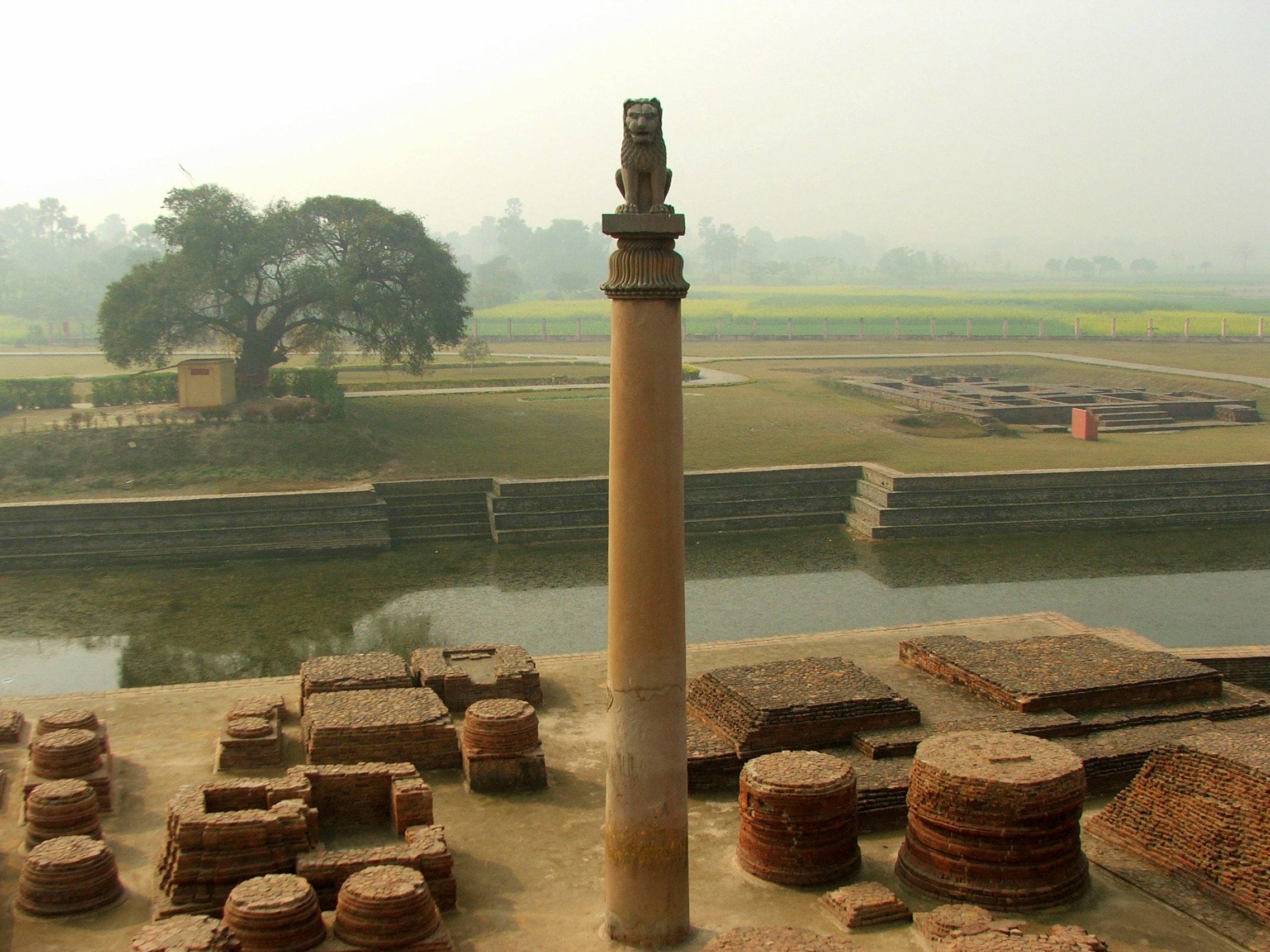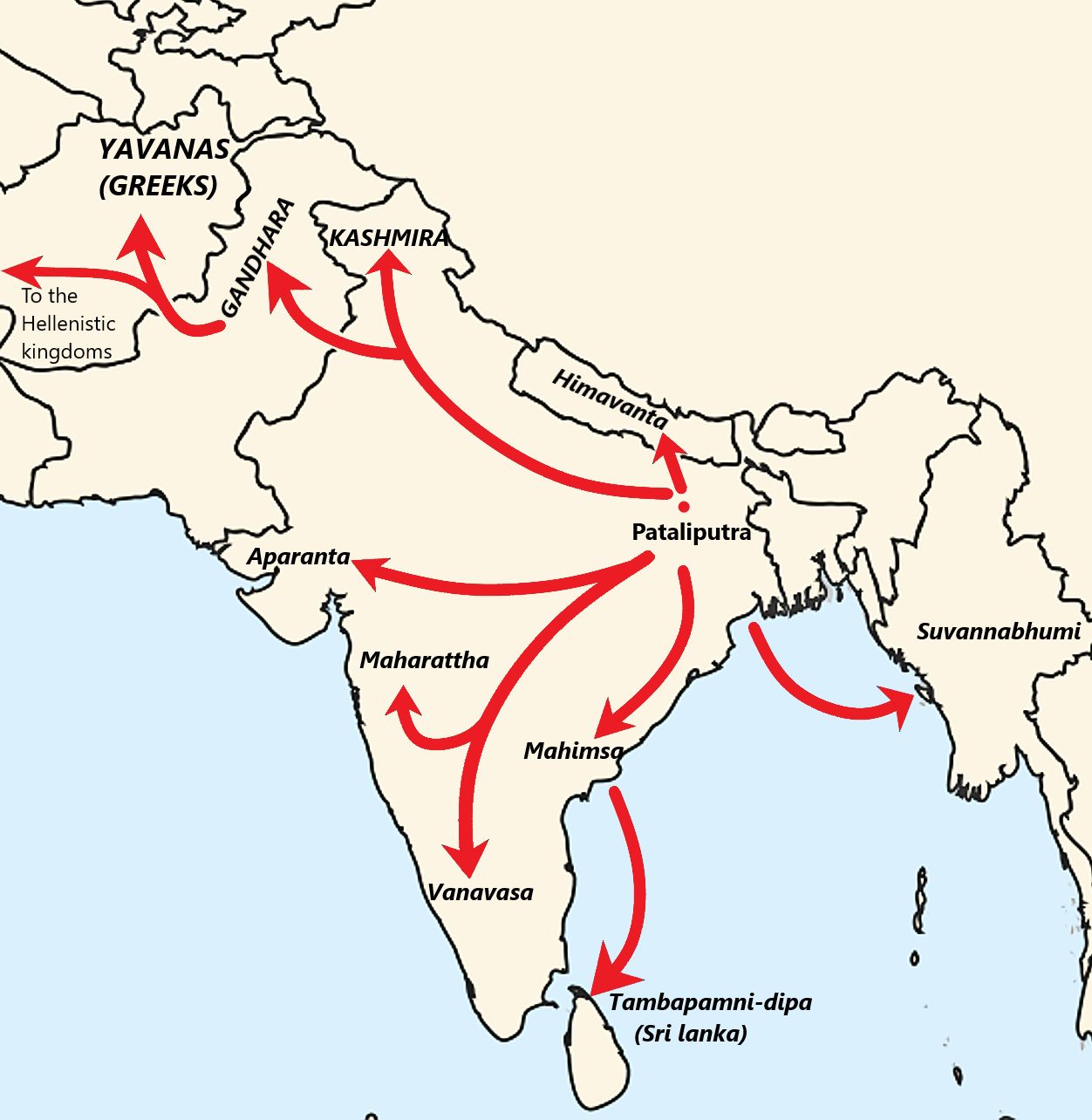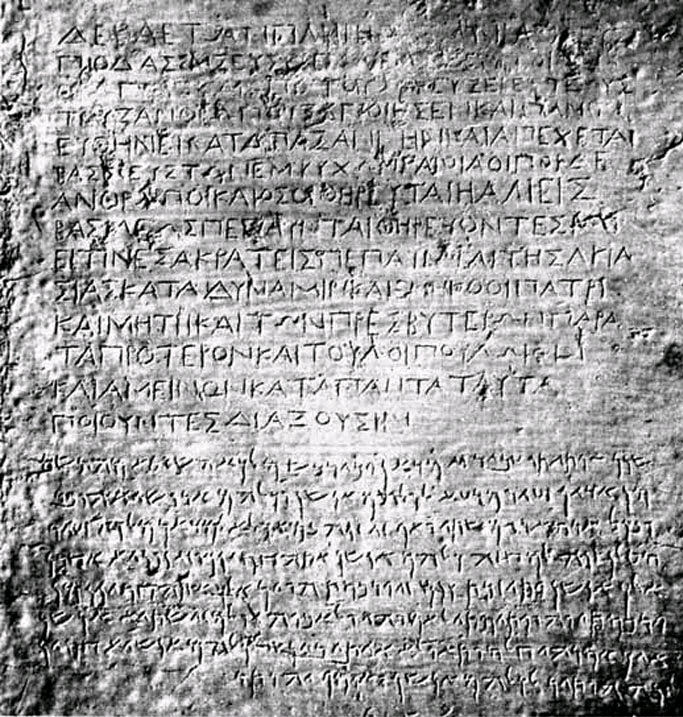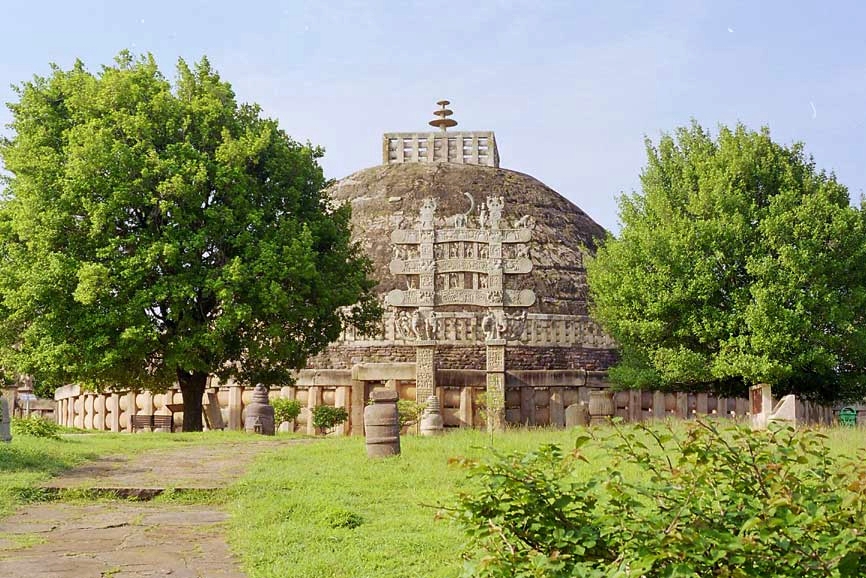Ashoka’s Empire: The first Buddhist state and its impact on the spread of Buddhism
Ashoka the Great, the third emperor of the Maurya dynasty, is a pivotal figure in the history of ancient India and the spread of Buddhism. Reigning from approximately 268 to 232 BCE, Ashoka inherited a vast empire stretching from the Hindu Kush in the west to Bengal in the east and from the Himalayas in the north to the Deccan Plateau in the south. While initially known for his military conquests and administrative prowess, Ashoka underwent a profound transformation following the bloody Kalinga War. This conversion marked the beginning of a unique period in Indian history, where a ruler actively promoted non-violence, compassion, and religious tolerance, primarily through the spread of Buddhist ideals. This post explores Ashoka’s reign, his policies, and their impact on the dissemination and success of Buddhism both within his empire and beyond.

Ashoka pillar at Vaishali. Ashoka’s edicts, inscribed on pillars and rock surfaces, highlight the ethical and administrative ideals of the Mauryan state, rooted in the Dharma, the Buddhist concept of moral law. Source: Wikimedia Commonsꜛ (license: CC BY-SA 2.5)
Ashoka’s early reign and the Kalinga War
Ashoka ascended the throne following a power struggle that ensued after the death of his father, Emperor Bindusara. The early years of his reign were marked by aggressive expansionist policies. The most notable of his military campaigns was the conquest of Kalinga, a prosperous region on the eastern coast of India. Despite achieving victory, the war inflicted massive casualties—historical accounts estimate that over 100,000 people were killed, and many more were displaced.

A c. 1st century BCE/CE relief from Sanchi, showing Ashoka on his chariot, visiting the Ramagrama. Source: Wikimedia Commonsꜛ (license: CC BY-SA 2.0)
The brutality of the Kalinga War deeply affected Ashoka. According to inscriptions in the Edicts of Ashoka, the emperor expressed profound remorse over the suffering caused by his campaign. This emotional and moral crisis prompted him to seek solace in Buddhist teachings. Ashoka’s adoption of Buddhism was not merely a personal decision but a transformative one that redefined his approach to governance and imperial policy.

Traditional depiction of the Maurya Empire under Ashoka as a solid mass of Maurya-controlled territory, c. 250 BCE. Source: Wikimedia Commonsꜛ (license: CC BY-SA 3.0)
Ashoka’s adoption of Buddhism
Ashoka’s conversion to Buddhism was not immediate or superficial. Historical evidence, particularly from his rock and pillar edicts, indicates a sincere commitment to the principles of Dhamma (a Pali term derived from the Sanskrit Dharma, meaning cosmic law and order). Unlike the traditional Vedic interpretation of Dharma, Ashoka’s Dhamma emphasized ethical conduct, non-violence (ahimsa), and respect for all life forms.

Mahabodhi Temple, built by Ashoka around 250 BCE. Source: Wikimedia Commonsꜛ (license: CC BY-SA 2.5)
Ashoka’s embrace of Buddhism led to a significant shift in state policy. He abandoned further military conquests and focused on internal consolidation and welfare. The administration under Ashoka implemented several reforms inspired by Buddhist ethics. He established hospitals for humans and animals, built roads and rest houses for travelers, and promoted agricultural development. While Ashoka personally adhered to Buddhism, he advocated religious tolerance and respect for all religious sects. This policy is evident in his edicts, where he urged his subjects to live harmoniously and respect each other’s beliefs. Additionally, Ashoka appointed Dhamma-mahamattas (officers of righteousness) to oversee the implementation of ethical policies and ensure the welfare of his people.
Ashoka’s Empire: The first Buddhist empire
Ashoka’s empire can reasonably be regarded as the first Buddhist empire in recorded history. It was the first major political power to adopt and promote Buddhism on a large scale, influencing the religion’s spread throughout Asia. While Ashoka did not enforce Buddhism as a state religion, his personal commitment and state-sponsored promotion of Buddhist ideals distinguish his rule as a uniquely Buddhist empire. This unprecedented integration of political power and Buddhist ethics created a model for later rulers who sought to combine governance with spiritual values.


Left: The Lion Capital of Ashoka in Sarnath, showing its four Asiatic lions standing back to back, and symbolizing the Four Noble Truths of Buddhism, supporting the Wheel of Moral law (Dharmachakra, reconstitution per Sarnath Museum notice). The lions stand on a circular abacus, decorated with dharmachakras alternating with four animals in profile: horse, bull, elephant, and lion. The architectural bell below the abacus is a stylized upside down lotus. Sarnath Museum. Source: Wikimedia Commonsꜛ (license: CC BY-SA 4.0) – Right: The Diamond throne at the Mahabodhi Temple, attributed to Ashoka. Source: Wikimedia Commonsꜛ (license: public domain)
The Role of Ashoka’s Edicts
One of Ashoka’s most significant contributions to the spread of Buddhism was his use of inscriptions to communicate his policies and beliefs. These inscriptions, known as the Edicts of Ashoka, were carved on rocks and pillars across his empire. Written in Prakrit, Greek, and Aramaic, these edicts were meant to reach diverse populations within the vast Mauryan Empire.


Left: Example inscription on the Minor Pillar Edict on the Sarnath pillar of Ashoka, 3rd century BCE. The edict is written in Prakrit, using the Brahmi script, and is one of the earliest known inscriptions of Ashoka. The edicts usually proclaim Ashoka’s conversion to Buddhism and his commitment to the welfare of his subjects, before common themes of dhamma and moral conduct. Source: Wikimedia Commonsꜛ (license: CC BY-SA 2.0) – Right: Distribution of Ashoka’s edicts. Source: Wikimedia Commonsꜛ (license: CC BY-SA 3.0)
The edicts can be classified into four categories. The Rock Edicts, found on large boulders, convey Ashoka’s adoption of Buddhism and his commitment to ethical governance. Pillar Edicts, erected at significant locations, often bear inscriptions promoting moral behavior, religious tolerance, and non-violence. Cave Inscriptions, found in caves used by ascetics, highlight Ashoka’s support for monastic communities. Finally, Minor Edicts, shorter inscriptions found in more remote areas of the empire, reinforce local adherence to Ashoka’s Dhamma.

Left: Approximate reconstitution of the Great Stupa at Sanchi under the Mauryas. Stupas were monumental structures used for Buddhist worship and relic storage, and Ashoka facilitated their construction across the empire under his reign. Source: Wikimedia Commonsꜛ (license: public domain) – Right: Remains of the Ashokan Pillar in Sanchi. Source: Wikimedia Commonsꜛ (license: CC BY-SA 3.0)
These inscriptions played a crucial role in disseminating Buddhist principles throughout the empire. They also helped create a unified cultural and ethical framework, fostering a sense of shared identity among Ashoka’s diverse subjects.
Ashoka’s missionary activities
Ashoka’s efforts to promote Buddhism extended beyond the boundaries of his empire. According to Buddhist texts, he dispatched missionaries to various regions. In Sri Lanka, Ashoka’s son Mahinda and daughter Sanghamitta are traditionally credited with introducing Buddhism to the island. They played a key role in converting the Sri Lankan king Devanampiya Tissa and establishing the Mahavihara monastery in Anuradhapura, which became a major center of Theravāda Buddhism.

 Left: Map of the Buddhist missions in Asia during the reign of Ashoka. Source: Wikimedia Commonsꜛ (license: CC BY-SA 4.0) – Right: Map of the Buddhist missions in Asia during the reign of Ashoka (broader view). Source: Wikimedia Commonsꜛ (license: public domain)
Left: Map of the Buddhist missions in Asia during the reign of Ashoka. Source: Wikimedia Commonsꜛ (license: CC BY-SA 4.0) – Right: Map of the Buddhist missions in Asia during the reign of Ashoka (broader view). Source: Wikimedia Commonsꜛ (license: public domain)
In Central Asia, missionaries were sent to regions such as Gandhara and Bactria, facilitating the spread of Buddhism along the Silk Road. Southeast Asia also saw the influence of Ashoka’s emissaries, with indications that they reached regions like Burma (Myanmar) and Thailand, planting the seeds for the later flourishing of Buddhism in these areas. Furthermore, Ashoka’s edicts mention the sending of envoys to Hellenistic kingdoms, including those of Antiochus II of Syria, Ptolemy II of Egypt, and Magas of Cyrene. While the impact of these missions remains uncertain, they reflect Ashoka’s ambition to promote Buddhism as a universal ethical system.
 Bilingual edict, Greek and Aramaic, by Indian Buddhist King Ashoka at Kandahar (Shar-i-kuna), 3rd century BCE. This edict advocates the adoption of “godliness” using the Greek term Eusebeia for Dharma. Preserved at Kabul Museum. Today disappeared. Two-dimensional inscription. Source: Wikimedia Commonsꜛ (license: public domain)
Bilingual edict, Greek and Aramaic, by Indian Buddhist King Ashoka at Kandahar (Shar-i-kuna), 3rd century BCE. This edict advocates the adoption of “godliness” using the Greek term Eusebeia for Dharma. Preserved at Kabul Museum. Today disappeared. Two-dimensional inscription. Source: Wikimedia Commonsꜛ (license: public domain)
Ashoka’s legacy and the success of Buddhism
Ashoka’s patronage provided Buddhism with the institutional support it needed to transition from a relatively small sect to a major religious movement. His policies of religious tolerance and ethical governance created an environment where Buddhist monastic communities could flourish. Monasteries established during Ashoka’s reign became centers of learning and spiritual practice, attracting scholars and pilgrims from distant lands.

Territories “conquered by the Dhamma” according to Major Rock Edict No.13 of Ashoka (260–218 BCE). Source: Wikimedia Commonsꜛ (license: CC BY-SA 4.0)
Moreover, Ashoka’s emphasis on non-violence and compassion resonated with a broad audience, enhancing Buddhism’s appeal across different social strata. His integration of Buddhist ethics into statecraft set a precedent for future rulers in India and beyond, contributing to the long-term success and survival of Buddhism as a global religion.
Conclusion
Ashoka the Great’s reign marked a turning point in the history of Buddhism. By adopting and promoting Buddhist principles, he not only transformed his empire but also laid the foundation for the religion’s spread across Asia. His use of edicts, support for monastic institutions, and missionary activities played a crucial role in shaping the development of Buddhism as a major world religion.

Stupa of Sanchi. The central stupa was built during the Mauryas, and enlarged during the Shungas, but the decorative gateway is dated to the later dynasty of the Satavahanas. Source: Wikimedia Commonsꜛ (license: CC BY 2.f)
References and further reading
- Thapar, Romila. Ashoka and the Decline of the Mauryas, 2012, Oxford University Press India, ISBN: 978-0198077244
- Gethin, R., The Foundations of Buddhism, 1998, Oxford University Press, ISBN: 978-0192892232
- Strong, John S. The Legend of King Ashoka: A Study and Translation of the Ashokavadana, 2002, Motilal Banarsidass Publications, ISBN: 978-8120806160
- Upinder Singh, A History of Ancient and Early Medieval India, 2009, Pearson Education, ISBN: 978-8131716779
- Johannes Bronkhorst, Greater Magadha: Studies in the culture of early India, 2024, Motilal Banarsidass Publishing House, ISBN: 978-9359663975










































comments